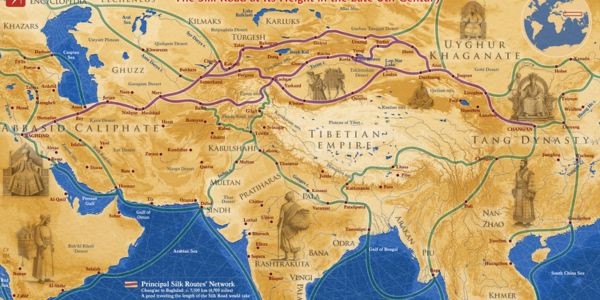Explore India’s pivotal role in the ancient Silk Route, from spices and textiles to cultural exchanges, and its lasting impact on global trade. Learn more at The Interview Times.
The ancient Silk Route, a sprawling network of trade pathways connecting Asia, Europe, and Africa, was a cornerstone of global economic and cultural exchange for centuries. India, with its strategic geographic position and rich resources, played a pivotal role in this intricate web of commerce. From spices and textiles to philosophical ideas and technological innovations, India’s contributions shaped the Silk Route’s legacy and left an indelible mark on global trade. This article explores India’s historical significance in the Silk Route and its enduring influence on international commerce.
India’s Strategic Position on the Silk Route
India’s geographic location made it a vital hub in the Silk Route’s vast network. Positioned between East Asia and the Mediterranean, India served as a bridge for goods, cultures, and ideas. Major Indian cities like Taxila, Pataliputra, and ports such as Bharuch and Muziris were bustling centers of trade, facilitating exchanges between Chinese, Persian, Roman, and Central Asian merchants.
The Silk Route was not a single road but a complex system of overland and maritime pathways. The overland routes, passing through Central Asia, connected India to regions like Bactria and Persia. Meanwhile, the maritime routes, known as the “Spice Route,” linked Indian ports to the Red Sea, East Africa, and Southeast Asia. These pathways enabled India to export its goods globally while importing luxury items like silk, glassware, and gold.
Must Read: Why Indian PhD Graduates Are in High Demand in European Research Institutions

India’s Trade Contributions to the Silk Route
India was a powerhouse of trade goods coveted across the ancient world. Its contributions to the Silk Route included:
1. Spices and Aromatics
India’s black pepper, cardamom, cinnamon, and turmeric were highly prized in Roman and Chinese markets. Known as “black gold,” pepper was so valuable that it was used as currency in some regions. Indian spices not only flavored cuisines but also served medicinal and preservative purposes, driving demand across continents.
2. Textiles
Indian cotton, silk, and muslin were renowned for their quality and craftsmanship. Cities like Varanasi and Madurai were textile hubs, producing fabrics that adorned royalty in Rome and China. The fine muslin, often called “woven air,” was a symbol of luxury, fetching high prices in foreign markets.
3. Precious Stones and Jewelry
India’s gemstones, including diamonds, sapphires, and pearls, were sought after by elites worldwide. The Kollur mines in Golconda produced some of the world’s finest diamonds, such as the Koh-i-Noor. Indian artisans excelled in crafting intricate jewelry, further enhancing the value of these exports.
4. Philosophical and Scientific Knowledge
Beyond material goods, India exported ideas that reshaped global thought. Buddhism, originating in India, spread along the Silk Route to Central Asia, China, and beyond, influencing art, architecture, and philosophy. Indian mathematical concepts, including the decimal system and zero, traveled westward, laying the foundation for modern mathematics.
5. Dyes and Craftsmanship
Indigo, a vibrant blue dye derived from Indian plants, was a major export, used in textiles across the Mediterranean. Indian craftsmanship in ivory, wood, and metalwork also found eager buyers, showcasing the country’s artistic prowess.
Must Read: Top 10 Free Online Libraries: A World of Books at Your Fingertips
Economic and Cultural Impact of India’s Role
India’s participation in the Silk Route had profound economic and cultural effects. Economically, trade brought immense wealth to Indian kingdoms like the Mauryas, Guptas, and Cholas. Ports and trade cities flourished, fostering urban development and infrastructure. The influx of foreign goods and coins, such as Roman denarii found in South India, underscores the scale of this commerce.
Culturally, the Silk Route transformed India into a melting pot of ideas. Interactions with Greek, Persian, and Chinese traders introduced new artistic styles, such as Greco-Buddhist art in Gandhara. Indian merchants also adopted foreign technologies, like glass-blowing, while spreading their own innovations, such as iron-making techniques.
The exchange of religions was equally significant. While Buddhism spread eastward, Zoroastrianism and early Christianity entered India through trade routes. Monastic centers like Nalanda became global hubs of learning, attracting scholars from across Asia.
Challenges and Decline of the Silk Route
Despite its success, the Silk Route faced challenges. Banditry, political instability, and harsh terrains posed risks to caravans. By the 7th century, the rise of Islamic empires and maritime trade began overshadowing overland routes. The decline of the Roman Empire and disruptions in Central Asia further diminished the Silk Route’s prominence. However, India’s maritime trade continued to thrive, with ports like Calicut and Cochin dominating spice exports in the medieval era.
India’s Trade Legacy in the Modern World
India’s role in the Silk Route laid the groundwork for its modern trade legacy. The country’s historical expertise in textiles, spices, and craftsmanship continues to influence global markets. Today, India remains a major exporter of textiles, pharmaceuticals, and IT services, echoing its ancient reputation for quality and innovation.
The Silk Route also symbolizes India’s enduring ability to connect cultures. Initiatives like the modern “Silk Road Economic Belt” and India’s participation in global trade forums reflect this legacy. By fostering economic and cultural ties, India continues to bridge East and West, much as it did millennia ago.
Conclusion
India’s role in the ancient Silk Route was transformative, shaping global trade and cultural exchange. From spices and textiles to philosophical ideas, India’s contributions enriched civilizations across Asia, Europe, and Africa. Its strategic position, vibrant economy, and cultural openness made it a linchpin of the Silk Route, leaving a legacy that resonates in today’s interconnected world. As we reflect on this historical journey, India’s trade heritage remains a testament to its enduring influence on global commerce.
Discover more historical insights and global stories at The Interview Times.
